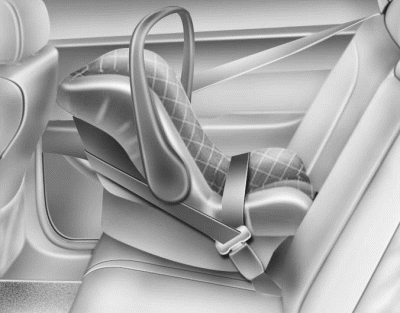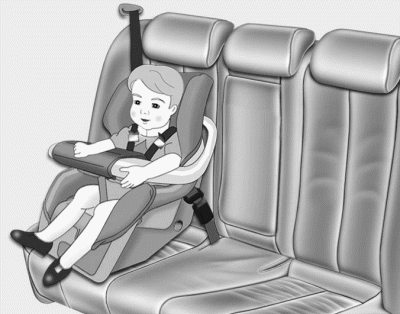Hyundai Tucson: Child restraint system / Selecting a Child Restraint System (CRS)
When selecting a CRS for your child, always:
- Make sure the CRS has a label certifying that it meets applicable Federal Motor Vehicle Safety Standards (FMVSS 213).
- Select a child restraint based on your childŌĆÖs height and weight. The required label or the instructions for use typically provide this information.
- Select a child restraint that fits the vehicle seating position where it will be used.
- Read and comply with the warnings and instructions for installation and use provided with the child restraint system.
Child restraint system types
There are three main types of child restraint systems: rear-facing seats, forward-facing seats, and booster seats. They are classified according to the childŌĆÖs age, height and weight.
Rear-facing child seats
WARNING
NEVER install a child or infant restraint in the front passengerŌĆÖs seat. Placing a rear-facing child restraint in the front seat can result in SERIOUS INJURY or DEATH if the child restraint is struck by an inflating air bag.

A rear-facing child seat provides restraint with the seating surface against the back of the child. The harness system holds the child in place, and in an accident, acts to keep the child positioned in the seat and reduce the stress to the neck and spinal cord.
All children under age one must always ride in a rear-facing infant child restraint.
Convertible and 3-in-1 child seats typically have higher height and weight limits for the rear-facing position, allowing you to keep your child rearfacing for a longer period of time.
Continue to use a rear-facing child seat for as long as your child will fit within the height and weight limits allowed by the child seat manufacturer.
ItŌĆÖs the best way to keep them safe. Once your child has outgrown the rear-facing child restraint, your child is ready for a forward-facing child restraint with a harness.

Forward-facing child restraints
A forward-facing child seat provides restraint for the childŌĆÖs body with a harness. Keep children in a forwardfacing child seat with a harness until they reach the top height or weight limit allowed by your child restraintŌĆÖs manufacturer.
Once your child outgrows the forwardfacing child restraint, your child is ready for a booster seat.
Booster seats
A booster seat is a restraint designed to improve the fit of the vehicleŌĆÖs seat belt system. A booster seat positions the seat belt so that it fits properly over the lap of your child. Keep your child in a booster seat until they are big enough to sit in the seat without a booster and still have the seat belt fit properly.
For a seat belt to fit properly, the lap belt must lie snugly across the upper thighs, not the stomach. The shoulder belt should lie snug across the shoulder and chest and not across the neck or face. Children under age 13 must always ride in the rear seats and must always be properly restrained to minimize the risk of injury.
 Child restraint system
Child restraint system
WARNING
Always properly restrain children in the rear seats of the vehicle. Children
of all ages are safer when restrained in the rear seat. A child riding in the front
passenger seat can be forc ...
 Installing a Child Restraint System (CRS)
Installing a Child Restraint System (CRS)
WARNING
Before installing your child restraint system always:
Read and follow the instructions provided by the manufacturer of the
child restraint.
Read and follow the instructions regarding ...
Other information:
Hyundai Tucson (LM) 2010-2015 Service Manual: Specifications
Specifications
ItemSpecificationMaster cylinderxLHDRHDTypeTandem typeTandem typeCylinder I.D.CBS: O 20.64O 25.4 mmABS/ ESP: O 22.22mmPiston stroke45mm(1.77in) / 30mm(1.18in)Fluid level switchProvidedProvidedBrake boosterxLHDRHDType11" Single8+9" TandemBoosting ratio9.0 : 19.0 ...
Hyundai Tucson (LM) 2010-2015 Service Manual: Console Repair procedures
Replacement
[M/T]
ŌĆó
Put on gloves to protect your hands.
ŌĆó
When prying with a flat-tip screwdriver, wrap it with
protective tape, and apply protective tape around the related parts, to
prevent damage.
ŌĆó
Use a plastic pane ...
